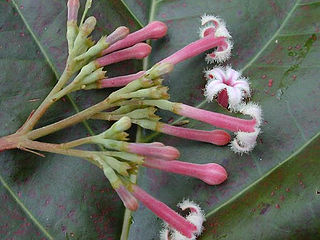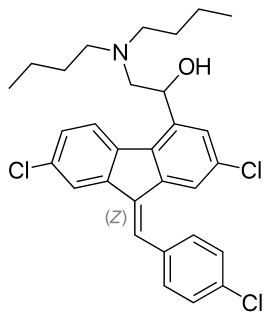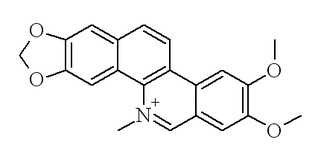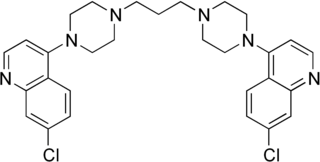 W
WAilanthone is an allelopathic chemical that is produced by the Ailanthus altissima tree which inhibits the growth of other plants.
 W
W8-Aminoquinoline is the 8-amino derivative of quinoline. It is structurally analogous to 8-hydroxyquinoline. The two nitrogen atoms are ideally situated to form complexes with metal ions. Derivatives of 8-aminoquinoline are effective directing groups in organic synthesis.
 W
WAmodiaquine (ADQ) is a medication used to treat malaria, including Plasmodium falciparum malaria when uncomplicated. It is recommended to be given with artesunate to reduce the risk of resistance. Due to the risk of rare but serious side effects, it is not generally recommended to prevent malaria. Though, the WHO in 2013 recommended use for seasonal preventive in children at high risk in combination with sulfadoxine and pyrimethamine.
 W
WAplasmomycin is an antibiotic with antimalarial activity isolated from Streptomycete.
 W
WArtelinic acid is an experimental drug that is being investigated as a treatment for malaria. It is a semi-synthetic derivative of the natural compound artemisinin. Artelinic acid has a lower rate of neurotoxicity than the related artemisinin derivatives arteether and artemether, but is three times more toxic than artesunate. At present, artelinic acid seems unlikely to enter routine clinical use, because it offers no clear benefits over the artemesinins already available. Artelinic acid has not yet been evaluated for use in humans.
 W
WArtemether is a medication used for the treatment of malaria. The injectable form is specifically used for severe malaria rather than quinine. In adults, it may not be as effective as artesunate. It is given by injection in a muscle. It is also available by mouth in combination with lumefantrine, known as artemether/lumefantrine.
 W
WArtemisinin and its semisynthetic derivatives are a group of drugs used against malaria due to Plasmodium falciparum. It was discovered in 1972 by Tu Youyou, who was co-recipient of the 2015 Nobel Prize in Medicine for her discovery. Treatments containing an artemisinin derivative are now standard treatment worldwide for P. falciparum malaria as well as malaria due to other species of Plasmodium. Artemisinin is isolated from the plant Artemisia annua, sweet wormwood, a herb employed in Chinese traditional medicine. A precursor compound can be produced using a genetically-engineered yeast, which is much more efficient than using the plant.
 W
WArtemotil, is a fast acting blood schizonticide specifically indicated for the treatment of chloroquine-resistant Plasmodium falciparum malaria and cerebral malaria cases. It is a semi-synthetic derivative of artemisinin, a natural product of the Chinese plant Artemisia annua. It is currently only used as a second line drug in severe cases of malaria.
 W
WArterolane, also known as OZ277 or RBx 11160, is a substance that was tested for antimalarial activity by Ranbaxy Laboratories. It was discovered by US and European scientists who were coordinated by the Medicines for Malaria Venture (MMV). Its molecular structure is uncommon for pharmacological compounds in that it has both an ozonide (trioxolane) group and an adamantane substituent.
 W
WArtesunate (AS) is a medication used to treat malaria. The intravenous form is preferred to quinine for severe malaria. Often it is used as part of combination therapy, such as artesunate plus mefloquine. It is not used for the prevention of malaria. Artesunate can be given by injection into a vein, injection into a muscle, by mouth, and by rectum.
 W
WAtovaquone, sold under the brand name Mepron, is a quinone antimicrobial medication for the prevention and treatment of Pneumocystis jirovecii pneumonia (PCP).
 W
WAzithromycin is an antibiotic used for the treatment of a number of bacterial infections. This includes middle ear infections, strep throat, pneumonia, traveler's diarrhea, and certain other intestinal infections. It can also be used for a number of sexually transmitted infections, including chlamydia and gonorrhea infections. Along with other medications, it may also be used for malaria. It can be taken by mouth or intravenously with doses once per day.
 W
WChloroquine is a medication primarily used to prevent and treat malaria in areas where malaria remains sensitive to its effects. Certain types of malaria, resistant strains, and complicated cases typically require different or additional medication. Chloroquine is also occasionally used for amebiasis that is occurring outside the intestines, rheumatoid arthritis, and lupus erythematosus. While it has not been formally studied in pregnancy, it appears safe. It is also being studied to treat COVID-19 as of 2020. It is taken by mouth.
 W
WChlorproguanil is an antimalarial drug.
 W
WCinchona is a genus of flowering plants in the family Rubiaceae containing at least 23 species of trees and shrubs. All are native to the tropical Andean forests of western South America. A few species are reportedly naturalized in Central America, Jamaica, French Polynesia, Sulawesi, Saint Helena in the South Atlantic, and São Tomé and Príncipe off the coast of tropical Africa, and others have been cultivated in India and Java, where they have formed hybrids.
 W
WCipargamin is an experimental synthetic antimalarial drug belonging to the spiroindolone class. The compound was developed at the Novartis Institute for Tropical Diseases in Singapore, through a collaboration with the Genomics Institute of the Novartis Research Foundation (GNF), the Biomedical Primate Research Centre and the Swiss Tropical Institute.
 W
WCodinaeopsin is an antimalarial isolated from a fungal isolate found in white yemeri trees (Vochysia guatemalensis) in Costa Rica. It is reported to have bioactivity against Plasmodium falciparum with an IC50 = 2.3 μg/mL (4.7 μM). Pure codinaeopsin was reported to be isolated with a total yield of 18 mg/mL from cultured fungus. The biosynthesis of codinaeopsin involves a polyketide synthase-nonribosomal peptide synthetase (PKS-NRPS) hybrid.
 W
WCryptolepine is an alkaloid with antimalarial and cytotoxic properties. It is able to intercalate into DNA at the cytosine-cytosine sites.
 W
WCycloguanil is a dihydrofolate reductase inhibitor, and is a metabolite of the antimalarial drug proguanil; its formation in vivo has been thought to be primarily responsible for the antimalarial activity of proguanil. However, more recent work has indicated that, while proguanil is synergistic with the drug atovaquone, cycloguanil is in fact antagonistic to the effects of atovaquone, suggesting that, unlike cycloguanil, proguanil may have an alternative mechanism of antimalarial action besides dihydrofolate reductase inhibition.
 W
WDihydroartemisinin is a drug used to treat malaria. Dihydroartemisinin is the active metabolite of all artemisinin compounds and is also available as a drug in itself. It is a semi-synthetic derivative of artemisinin and is widely used as an intermediate in the preparation of other artemisinin-derived antimalarial drugs. It is sold commercially in combination with piperaquine and has been shown to be equivalent to artemether/lumefantrine.
 W
WDoxycycline is a broad-spectrum tetracycline-class antibiotic used in the treatment of infections caused by bacteria and certain parasites. It is used to treat bacterial pneumonia, acne, chlamydia infections, Lyme disease, cholera, typhus, and syphilis. It is also used to prevent malaria and in combination with quinine, to treat malaria. Doxycycline may be taken by mouth or by injection into a vein.
 W
WELQ-300 is an experimental antimalarial medication. It is the first entry in a new class of antimalarials known as 4-quinolone-3-diarylethers.
 W
WGanaplacide is a drug in development by Novartis for the purpose of treating malaria. It belongs to the class of the imidazolopiperazines. It has shown activity against the Plasmodium falciparum and Plasmodium vivax forms of the malaria parasite.
 W
WHalofantrine is a drug used to treat malaria. Halofantrine's structure contains a substituted phenanthrene, and is related to the antimalarial drugs quinine and lumefantrine. Marketed as Halfan, halofantrine is never used to prevent malaria and its mode of action is unknown, although a crystallographic study showed that it binds to hematin in vitro, suggesting a possible mechanism of action. Halofantrine has also been shown to bind to plasmepsin, a haemoglobin degrading enzyme unique to the malarial parasites.
 W
WHydroxychloroquine, sold under the brand name Plaquenil among others, is a medication used to prevent and treat malaria in areas where malaria remains sensitive to chloroquine. Other uses include treatment of rheumatoid arthritis, lupus, and porphyria cutanea tarda. It is taken by mouth, often in the form of hydroxychloroquine sulfate. Hydroxychloroquine is being studied to prevent and treat coronavirus disease 2019 (COVID‑19), but all clinical trials conducted during 2020 found it is ineffective and may cause dangerous side effects.
 W
WJesuit's bark, also known as cinchona bark, Peruvian bark or China bark, is a former name of a supposed remedy for malaria, as the bark contains quinine used to treat the disease. The bark of several species of the genus Cinchona, family Rubiaceae indigenous to the western Andes of South America, was discovered as a folk medicine treatment for malaria by Jesuit missionaries in Peru during the 17th century.
 W
WLumefantrine is an antimalarial drug. It is only used in combination with artemether. The term "co-artemether" is sometimes used to describe this combination. Lumefantrine has a much longer half-life compared to artemether, and is therefore thought to clear any residual parasites that remain after combination treatment.
 W
WMefloquine, sold under the brand name Lariam among others, is a medication used to prevent or treat malaria. When used for prevention it is typically started before potential exposure and continued for several weeks after potential exposure. It can be used to treat mild or moderate malaria but is not recommended for severe malaria. It is taken by mouth.
 W
WMepacrine, also called quinacrine or by the trade name Atabrine, is a medication with several uses. It is related to chloroquine and mefloquine. Although formerly available from compounding pharmacies, as of August 2020 it is unavailable in the United States.
 W
WNeurolenin B is an antimalarial chemical isolated from Eupatorium inulaefolium.
 W
WNitidine is a benzophenanthridine alkaloid found in species of the genus Zanthoxylum , notably in Zanthoxylum nitidum. This compound has an anti-malarial activity.
 W
WOlivacine is an antimalarial alkaloid.
 W
WOroidin is a bromopyrrole alkaloid, originally isolated from sponges in the genus Agelas. Oroidin possesses moderate antimalarial activity.
 W
WPamaquine is an 8-aminoquinoline drug formerly used for the treatment of malaria. It is closely related to primaquine.
 W
WPiperaquine is an antiparasitic drug used in combination with dihydroartemisinin to treat malaria. Piperaquine was developed under the Chinese National Malaria Elimination Programme in the 1960s and was adopted throughout China as a replacement for the structurually similar antimalarial drug chloroquine. Due to widespread parasite resistance to piperaquine, the drug fell out of use as a monotherapy, and is instead used as a partner drug for artemisinin combination therapy. Piperaquine kills parasites by disrupting the detoxification of host heme.
 W
WPrimaquine is a medication used to treat and prevent malaria and to treat Pneumocystis pneumonia. Specifically it is used for malaria due to Plasmodium vivax and Plasmodium ovale along with other medications and for prevention if other options cannot be used. It is an alternative treatment for Pneumocystis pneumonia together with clindamycin. It is taken by mouth.
 W
WProguanil, also known as chlorguanide and chloroguanide, is a medication used to treat and prevent malaria. It is often used together with chloroquine or atovaquone. When used with chloroquine the combination will treat mild chloroquine resistant malaria. It is taken by mouth.
 W
WPyrimethamine, sold under the brand name Daraprim among others, is a medication used with leucovorin to treat the parasite diseases toxoplasmosis and cystoisosporiasis. It is also used with dapsone as a second-line option to prevent Pneumocystis jiroveci pneumonia in people with HIV/AIDS. It was previously used for malaria but is no longer recommended due to resistance. Pyrimethamine is taken by mouth.
 W
WPyronaridine is an antimalarial drug. It was first made in 1970 and has been in clinical use in China since the 1980s.
 W
WQuinine is a medication used to treat malaria and babesiosis. This includes the treatment of malaria due to Plasmodium falciparum that is resistant to chloroquine when artesunate is not available. While sometimes used for restless legs syndrome, quinine is not recommended for this purpose due to the risk of serious side effects. It can be taken by mouth or intravenously. Malaria resistance to quinine occurs in certain areas of the world. Quinine is also the ingredient in tonic water that gives it its bitter taste.
 W
WSemapimod (INN), formerly known as CNI-1493, is an investigational new drug which has anti-inflammatory, anti-cytokine, immunomodulatory, antiviral and antimalarial properties.
 W
WThe spiroindolones are a class of compounds in which an indolone ring is substituted with another ring in a spiro arrangement.
 W
WSulfadoxine is an ultra-long-lasting sulfonamide used in combination with pyrimethamine to treat malaria.
 W
WSulfalene or sulfametopyrazine (BAN) is a long-acting sulfonamide antibacterial used for the treatment of chronic bronchitis, urinary tract infections and malaria. As of 2014 there were only two countries in which it is currently still marketed: Thailand and Ireland.
 W
WTafenoquine, sold under the brand name Krintafel among others, is a medication used to prevent and to treat malaria. With respect acute malaria it is used together with other medications to prevent relapse by Plasmodium vivax. It may be used to prevent all types of malaria. It is taken by mouth.
 W
WVoacamine, also known under the older names voacanginine and vocamine, is a naturally occurring dimeric indole alkaloid of the secologanin type, found in a number of plants, including Voacanga africana and Tabernaemontana divaricata.